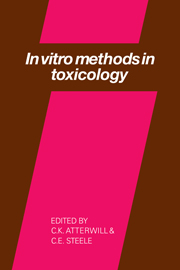The chorioallantoic membrane in irritancy testing
Published online by Cambridge University Press: 06 August 2010
Summary
INTRODUCTION
There has been increasing pressure over recent years to find suitable alternative procedures to the Draize rabbit eye test (Draize et al., 1944). The majority of the proposed substitute tests are cell culture systems or isolated tissue preparations. As yet none of these potential alternative techniques have either been generally accepted or fully validated. Included amongst these techniques are the isolated rabbit ileum, from which results have at times been found to be inconsistent (Muir, 1984a), and bovine cornea (Muir, 1984b). The cell culture systems examined are wide ranging both in cell type and also the proposed end point which can be based on morphology or various biochemical tests. Some examples of these end points include uridine uptake (Shopsis & Sathe, 1984) histamine release (Prottey & Ferguson, 1975) and neutral red uptake (Hockley & Baxter, in press) while the different cell types include rabbit corneal cell (North-Root et al., 1982) and human diploid fibroblasts (Knox, in press). A system for assessing skin corrosivity has been proposed by Pemberton et al., (in press) which employs rat epidermal skin slices.
At our laboratories the isolated whole eye organ preparation, the in vitro eye corneal injury test, is used routinely to assist in assessing the potential of materials to damage the cornea (Burton et al., 1981; York et al., 1982). This system has been quite widely used and has been included in the Guidelines for the Testing of Chemicals for Toxicity (HMSO 1982) as a possible screening method.
- Type
- Chapter
- Information
- In Vitro Methods in Toxicology , pp. 263 - 278Publisher: Cambridge University PressPrint publication year: 1987
- 2
- Cited by



